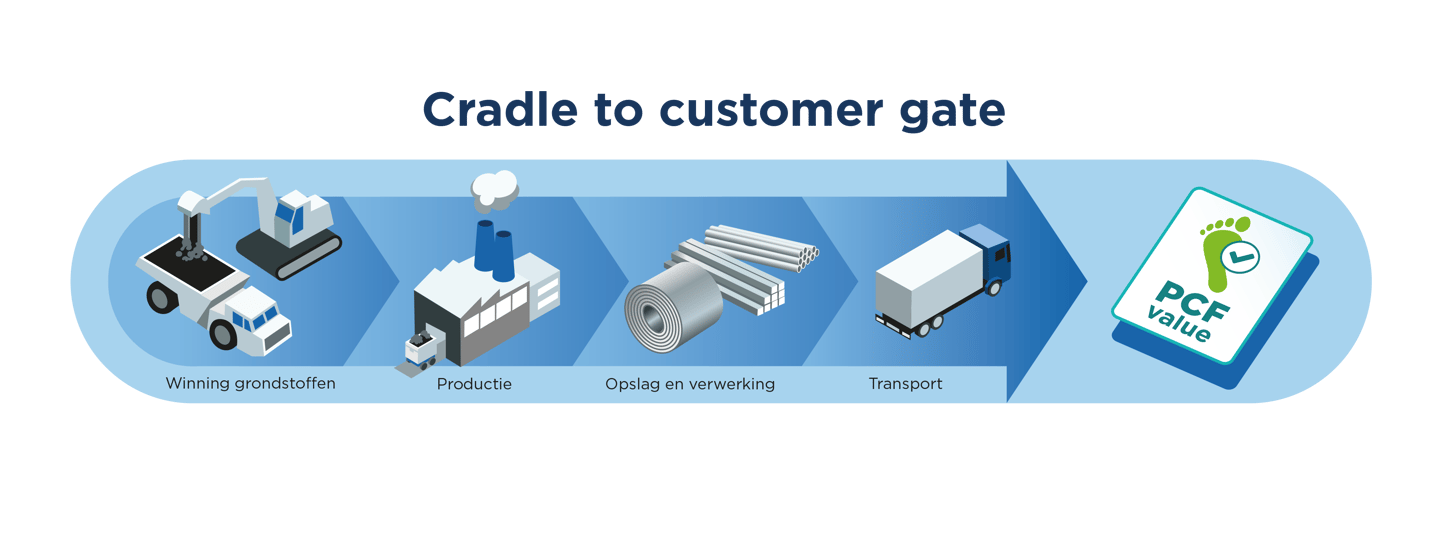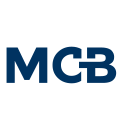%20PCF%20English.jpg)
Insight into the CO2 footprint of your metal products
With MCB’s PCF subscription, you gain insight into the CO₂ footprint (Product Carbon Footprint, PCF) of the products you purchase from us. For each product delivered, you automatically receive a PCF certificate and an overview of CO₂ emissions per order line, per month, and per year. This also includes the potential reduction achieved through the purchase of CORE green certificates. You can also request individual PCF certificates for each order line.
The overviews provided through the PCF subscription, together with the CORE certificates, can be used not only for your sustainability reporting but also to share with your customers. Thanks to the PCF subscription, you can report an equivalent emission of Scope 3 emissions, in accordance with the guidelines of the Greenhouse Gas Protocol Corporate Accounting and Reporting Standard.
Reliable and transparent PCF calculation
The Product Carbon Footprint is the sum of all steps in the production process up to delivery to our customers: from raw material extraction and production to processing, storage, and delivery of each product (cradle to customer gate). The foundation of the MCB Carbon Bank is the valuation of CO₂ reduction based on the Product Carbon Footprint (PCF). All steel, stainless steel, and aluminum products have been assigned a PCF value verified and assured by DNV.
Our PCF methodology has been developed in accordance with the GHG Protocol Product Life Cycle Accounting and Reporting Standard. The calculations are based on an established methodology and verified data, ensuring that you can rely on a trustworthy and transparent representation of the environmental impact per ton of product. Both the CO₂ savings and the associated purchase of CORE green certificates have been audited and verified by DNV Business Assurance B.V.

Strict control and assurance by DNV
Verification, assessment, and approval
Before granting approval, DNV reviews various processes, including the reliability of the sources utilised, the accuracy of calculations, the systems employed to support these calculations, the rationale behind additions to the Carbon Bank, and the principles, rules, and techniques applied.
DNV is a specialist in the assurance of companies, with a strong emphasis on sustainability and environmental performance. As a leading entity with proven expertise and in-depth knowledge of the metal sector, DNV is a trusted and experienced partner for our sustainability initiatives.
DNV undertakes two primary tasks:
- Monitoring our CO2 emissions, carbon bank, and green products.
- Assuring our CORE green certificates and PCF certificates, including the relevant reporting.
What does MCB's PCF subscription entail?
Content
The Product Carbon Footprint is the calculation of the CO₂eq emissions per ton of product. The Product Carbon Footprint is the sum of all steps in the production process up to delivery to our customers: from raw material extraction and production to processing, storage, and delivery of each product (Cradle to customer gate).
The covered material groups are: steel, stainless steel, and aluminium.
By default, each delivered product comes with a PCF certificate and an overview of CO₂ emissions per order line, per month, and per year. This also includes the potential reduction achieved through the purchase of CORE green certificates.
Methodology
MCB uses its own methodology for calculating the Product Carbon Footprint (PCF), in accordance with the Greenhouse Gas Protocol for Product Life Cycle Accounting and Reporting.
The calculation is based on both primary and secondary data. Primary data are collected directly within MCB and include, among other things, direct emissions (Scope 1), such as gas and diesel consumption, indirect emissions from purchased electricity (Scope 2), and transport emissions to customers by external parties (Scope 3).
Secondary data are sourced from external references such as EPDs (Environmental Product Declarations), recognized databases, and green certificates from our suppliers. These data mainly relate to Scope 3 emissions in the value chain, such as the production of raw materials.
Verification
The applied methodology and data usage have been assessed against the following criteria:
-
The Greenhouse Gas Protocol
-
MCB’s internal methodology
-
The definition of the CO₂eq footprint: emissions in metric tons of CO₂eq per ton of product
In addition, the calculations and certificates are verified by DNV.
Frequently asked questions
What is a Product Carbon Footprint (PCF)
A PCF represents the CO₂ emissions generated in producing one ton of material, from raw material extraction to delivery to the customer (“cradle-to-customer gate”). MCB calculates this footprint based on its own data (Scope 1, 2, and transport) and supplier data (Scope 3).
How is the PCF value calculated at MCB?
The Product Carbon Footprint (PCF) of MCB represents the CO₂ emissions of a product, measured from raw material extraction to delivery to the customer – also referred to as cradle-to-customer gate.
The calculation follows the Greenhouse Gas Protocol and is based on a combination of:
Primary data (collected directly within MCB):
-
Scope 1: direct emissions, such as gas and diesel consumption at our sites
What is a CORE-certificate?
A CORE certificate is an official, certified proof that you have purchased sustainable metal from MCB, including a demonstrable CO₂ reduction. This reduction is calculated in accordance with the Greenhouse Gas Protocol and verified by an independent party. With this certificate, you can include the related Scope 3 emission reduction in your own sustainability reporting.
What is the difference between a PCF and a CORE certificate?
- PCF: shows the CO₂ emissions of a specific product.
- CORE: a certificate demonstrating that the customer has purchased sustainable metal, including a potential reduction in Scope 3 emissions through the use of green energy (via certificates).
What are Scope 1,2 and 3 emissions?
-
Scope 1: direct emissions (e.g., from own facilities)
-
Scope 2: indirect emissions from purchased energy
-
Scope 3: other indirect emissions in the value chain (e.g., transport, suppliers, waste)
What is CSRD?
Since 2024, the Corporate Sustainability Reporting Directive (CSRD) requires large companies to report annually on their sustainability impact, covering areas such as climate, human rights, and governance. Smaller companies may also be affected through supply chain responsibility, as large companies are required to account for the sustainability performance of their suppliers.
What is CSDDD?
The CSDDD (Corporate Sustainability Due Diligence Directive) requires large companies to take active measures against human rights violations and environmental damage within their supply chain. It focuses on taking concrete action and preventing or mitigating risks.
What is the Greenhouse Gas Protocol (GHG)?
The Greenhouse Gas (GHG) Protocol is a globally recognized standard for measuring and reporting greenhouse gas emissions. It is used, among other things, for calculating Scope 1, 2, and 3 emissions and the PCF of products.
What is the EU CBAM?
The Carbon Border Adjustment Mechanism is an EU measure that ensures imported products comply with the same CO₂ standards as those within the EU. It is not a tax, but a price adjustment based on the product’s CO₂ emissions.
Together more sustainable with our CO2 reduced CORE products
When it comes to sustainability, we like to take our responsibility. With the arrival of our CORE products, we make ordering greener products more accessible to all our customers. By choosing one of the three CO2-reduced CORE variants (-33%, -66% or -100% CO2 emissions), you can decide how much CO2 you want to save. For each purchased CORE product, you will receive a CORE certificate as proof of your CO2-reduced purchase (Scope 3). The obtained green certificates can be used for your sustainability reporting (Scope 3) and made available to your customers. In this way, we can collectively contribute to making the metal chain more sustainable. Are you in?

Wood4Wood: palletrecycling with green certificates
Our Wood4Wood programme seamlessly aligns with MCB's sustainability vision. By 2030, we aim to reuse at least 80% of our pallets. Therefore, we collect all pallets free of charge during the return trips of our deliveries. This can be done on demand or on scheduled pickup days. After inspection and any necessary repairs, the pallets are reused as much as possible.
Annually, you will receive a certified green certificate detailing the CO2 savings, which you can use for your sustainability reporting (Scope 3). In this way, we contribute together to the sustainability of the metal supply chain.

